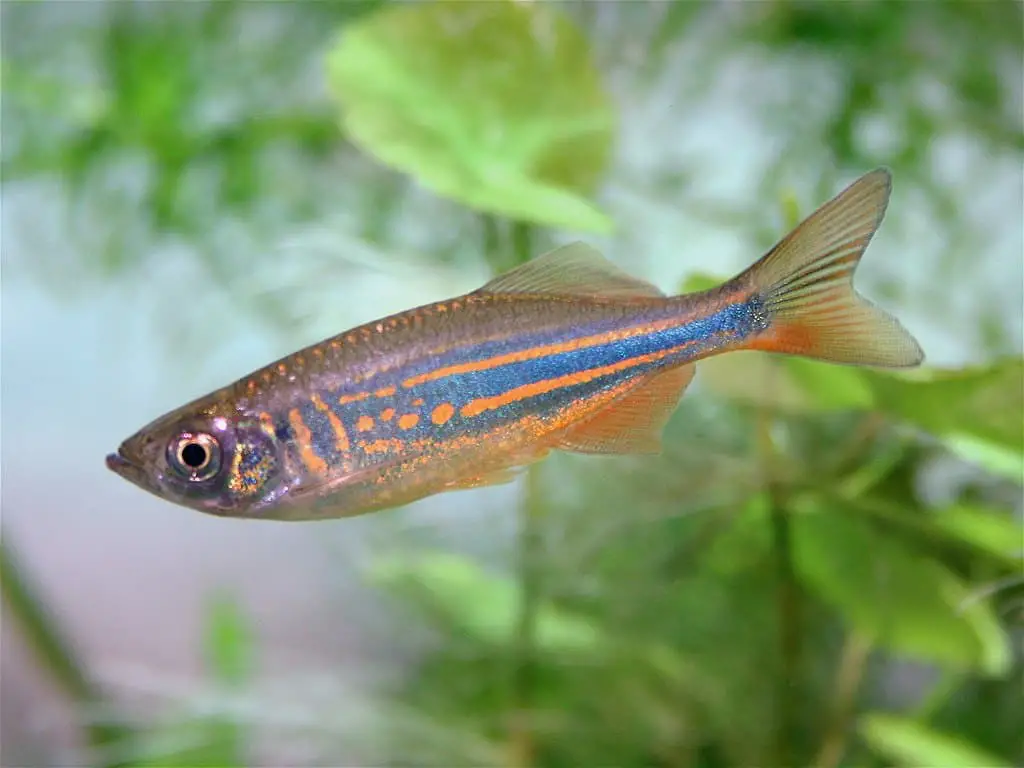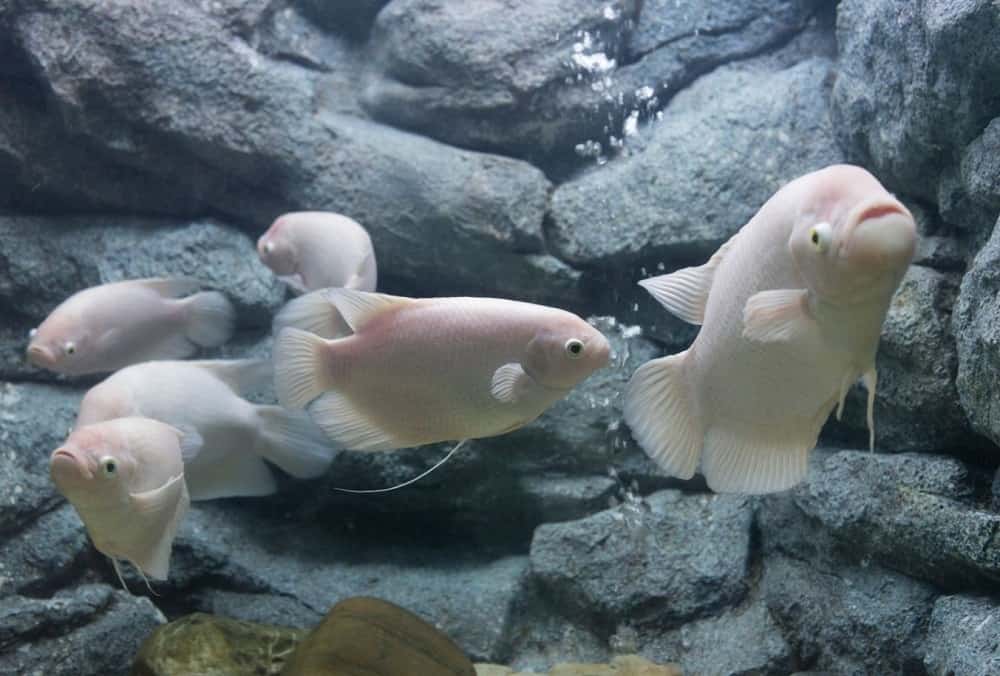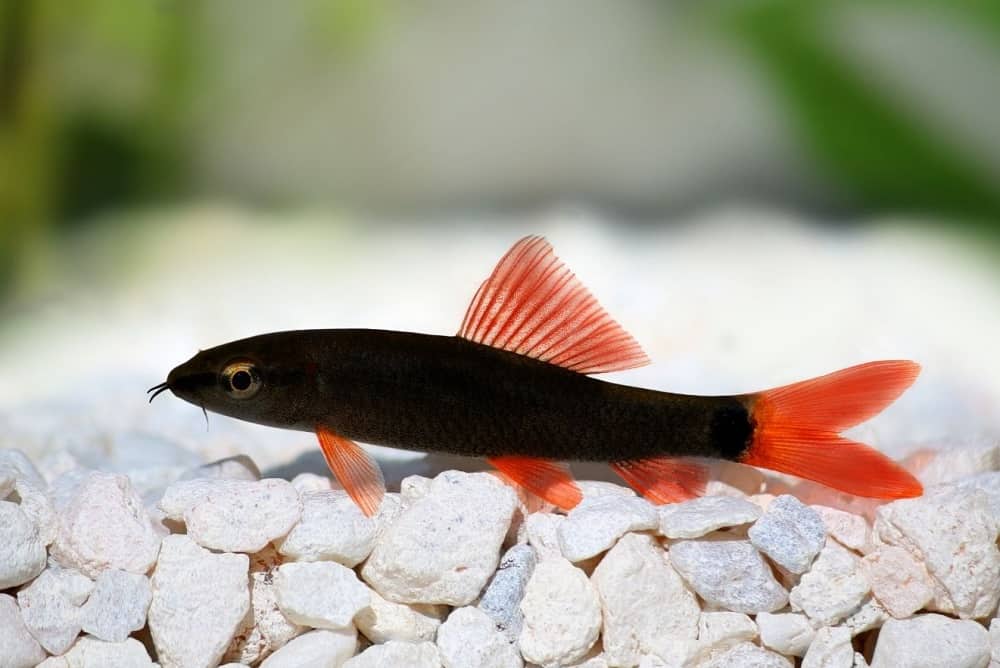The Giant Danio (Devario aequipinnatus) is a unique and highly active fish in the aquarium, especially in large schools. They are generally found in Sri Lanka, Nepal, and the west coast of India
They feature an exciting pattern of markings and a luminescence that brings balance and beauty to any home aquarium.

Species Summary
Also known as Malabar Danio, the Giant Danio is distributed over a wide area of eastern India. However, it is a species that lacks further study of its geographic distribution.
Devario aequipinnatus is a tropical freshwater fish species belonging to the Cyprinidae family. Because they have a wide distribution area, they are found in different habitats, such as streams, tributaries of large bodies of water, and small rivers with marginal vegetation or current sites with a substantial presence of rocks. Its habitat is likely to vary in physical and chemical patterns related to the dry and rainy seasons.
They are medium-sized schooling fish. These danios display a unique marking pattern on their body, which, together with their bluish iridescence, impact the viewer remarkably.
It is a relatively common species in aquariums, given its low price and rusticity; their limiting factor is a large amount of space they need.
Overall, the Giant Danio is a resilient fish and relatively easy to keep, making it an excellent choice for beginning aquarists.
Care Guide
Giant Danio are very active and adaptable, and can live in community aquariums with other peaceful fish without any problems.
Like other shoal fish, the Giant Danio must be kept in groups of at least eight individuals of the species. They are found in large schools containing thousands of them in the wild.
When taken care of, Giant Danio is a lovely fish, but they will show their best colors when given a balanced diet and a suitable aquarium.
It is a resistant and easy-to-care fish, but that does not exclude knowing the species, its habits, and behaviors in depth. Like any other species, Giant Danio has its peculiarities, addressed and detailed in the following topics.
Tank Size
Giant Danios are very active fish and should be kept in schools, with ample free space for swimming. A 48” x 12” or at least 50 gallon tank is a good size to start with a small school. But like most shoal fish, the more space and the bigger the shoal, the better for the well-being of the fish.
Tankmates
As they are peaceful fish and coexist without problems with other animals, they can live with countless other species of fish in a community aquarium. Avoid aggressive species that could injure Giant Danio or compete directly for food.
This danio can bother slow or shy fish with its constant activity and vigorous feeding behavior. It is best to keep them with fish of similar size and behavior.
This species may come to bite fish with very flashy and exuberant fins, such as Bettas and Guppies; in this case, pay extra attention to the aquarium.
Same Species Tanks
They are often used as a single species in assemblages of biotope-type aquariums, where the original location where the species occurs is imitated.
It is a great species to be kept alone in a well-decorated aquarium, a large school of Giant Danios will give a beautiful sense of motion in virtually any kind of tank.
Water Parameters
They are incredibly resistant fish, which support a wide range of parameters.
This danio can live with outstanding quality in different parameters; the perfect temperature for its maintenance is 64 to 77 F. The ideal pH range is between 6.0 to 8.0 and hardness from 36 to 268 ppm.
This difference between hardness and pH is related to the region of origin of the specimen and demonstrates the oscillation of parameters during the dry and rainy seasons.
What to Put in Their Tank
As for any other aquatic animal, an aquarium heater and a filtering system are essential to keep the tank with Giant Danio healthy.
These fish are fantastic jumpers, so the lid should be appropriately fixed.
The filtration system must be well dimensioned; this species prefers medium to moderate water flow and benefits from a large concentration of O² available in the water.
The tank decoration is not restrictive in keeping the species in captivity. Given its highly dynamic behavior, you have to provide plenty of free space for swimming.
Common Diseases
They are remarkably disease-resistant fish. When you keep the water and the tank in excellent condition and provide good quality food, your fish should not present any problems.
The species has low resistance to pollutants and nitrogen dispersed in the water column. Always keep the water in ideal condition.
Food and Diet
Like other danios, this species is omnivorous, feeding mainly on small invertebrates and larvae.
Being great eaters, this fish readily accepts commercial feeds in aquariums without problems. Dry, live, and fresh foods such as daphnia, brine shrimp, bloodworms, mosquito larvae, and others are highly beneficial to fish and should be fed regularly.
Providing a varied and balanced diet is essential for demonstrating its full potential. These are usually fish that are always hungry.
Lifespan
In an aquarium with all the correct parameters kept stable and with an ideal diet, this fish can live for 3 to 5 years.
In nature, these animals are prone to live less, as they are predisposed to diseases, attacks from other animals, and environmental causes.
Appearance
Giant Danio is a torpedo-shaped fish with a hydrodynamic appearance.
Its body features iridescent gold tones with deep electric blue spots and randomly shaped stripes longitudinally from the gills to the tail.
The fins are pale yellow and round, while the tail fin is bifurcated, resembling other danios.
Size
The Giant Danio fish can quickly grow to 4-6 inches in length when well cared for and fed.
Behavior and Temperament
It is a tropical fish species with peaceful behavior and can be kept in a community aquarium with fish of the same size and behaviour. As it is a fish with gregarious habits, it will be essential to keep a school of at least eight animals to show their natural behavior and more enhanced colors.
They are very active animals, occupying practically all strata of the tank; however, they prefer to feed on the surface.
Breeding
Captive breeding is extremely simple and is carried out commercially and even accidentally in home aquariums worldwide.
It is an oviparous species, where the female dumps the eggs in the middle (egg-scattering species). The male will lead the female to release the eggs freely, which will then be fertilized by him; most of the eggs will go to the bottom of the aquarium or stay in the middle of a cluster of plants. The eggs will hatch in up to two days. Parents do not exhibit any parental care.
They prefer to breed in slightly acidic waters. They are generally bred in breeding tanks, with something at the bottom – like a mesh – preventing the parents from eating the eggs until they are removed to another location. The fingerlings are tiny; they must be fed with paramecium or another type of infusoria until they are big enough to accept other foods.
They are easily reproduced fish, where spontaneous reproduction can occur in any domestic aquarium, as long as it is in good conditions.
Gender Differences: Male vs. Female
There is apparent sexual dimorphism. Males are more colorful, slightly smaller and have a more straight body, while females have a more robust body with a plumper shape.
Giant Danio Fun Facts
This species is prevalent in the aquarium hobby and commercially reproduced in several countries, due to its rusticity.
When kept in numerous schools, they tend to be calmer, and males show a more striking coloration due to disputes.
Genetic and morphological data revealed that fish marketed for ornamental purposes under the name ‘Giant Danio’ “D. aequipinnatus” in most of the older aquarium literature are actually described as “D. malabaricus“
References
Kullander, F.F., 2001. Phylogeny and species diversity of the South and Southeast Asian cyprinid genus Danio Hamilton (Teleostei, Cyprinidae). Ph.D. Thesis-Stockholm University, Department of Zoology. p. 1-26. Sweden, Stockholm University. Department of Zoology.
Menon, A.G.K., 1999. Check list – fresh water fishes of India. Rec. Zool. Surv. India, Misc. Publ., Occas. Pap. No. 175, 366 p.
Robins, C.R., R.M. Bailey, C.E. Bond, J.R. Brooker, E.A. Lachner, R.N. Lea and W.B. Scott, 1991. World fishes important to North Americans. Exclusive of species from the continental waters of the United States and Canada. Am. Fish. Soc. Spec. Publ. (21):243 p.








